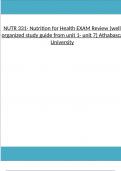NUTR 331- Nutrition for Health EXAM Review (well
organized study guide from unit 1- unit 7) Athabasca
University
,UNIT 1
After completing this unit, you should be able to
1. define nutrition.
2. discuss the nature of nutrients.
3. describe four methods of assessing nutritional status.
4. describe four methods of diet information collection for nutritional analysis
of individuals or groups of people.
5. explain the uses and limitations of food composition databases.
1. nutrition the study of the nutrients and other biologically active compounds
in foods and in the body; sometimes also the study of human behaviors related
to foo
nutrition the study of the nutrients and other biologically active compounds in
foods and in the body; sometimes also the study of human behaviors related to
foo
nutrition the study of the nutrients and other biologically active compounds in
foods and in the body; sometimes also the study of human behaviors related to
foo
nutrition the study of the nutrients and other biologically active compounds in
foods and in the body; sometimes also the study of human behaviors related to
foo
nutrition the study of the nutrients and other biologically active compounds in
foods and in the body; sometimes also the study of human behaviors related to
foo
1. Nutrition is the study of nutrients and other biological active compounds in foods and in
the body; sometimes also the study of human behaviors related to food
2a. The 6 major classes of nutrients are carbs, lipids (fats), proteins, vitamins, minerals and
water
b. -Carbs, lipids, proteins and water care called macronutrients
energy yielding nutrients
-vitamins and minerals are called micronutrients
smaller amounts (Milligrams or
micrograms) 3i. Persons diet
Persons history are recorded, including medical history, particularly of diet-related conditions
Eg: Alcoholism, anorexia, cancer
Socioeconomic history is also important, because it provides information about
personal, financial and environmental influences on food intake
Poor education tends to influence diet so does living alone
ii. Anthropometric measures
The physical characteristics of the body such as height and weight which alerts the
assessor to serious problems
Growth failure in children, wasting or swelling of body tissues in adults and obesity
,iii. Physical Examination
Looks for clues to poor nutritional health status
Various parts of the body can be inspected such as hair, eyes, skin, tongue and
fingernails; posture may also be assessed
Can provide evidence of deficiencies, imbalances, and toxicity status
iv. Laboratory test
Taking samples of body fluids, such as blood or urine, and analyze them
Early stage of malnutrition body changes may not be obvious, but biochemical lab tests
may reveal problems
Most well-known tests is blood hemoglobin, which indicates weather iron levels are in
the normal range
Biochemical abnormalities shown by lab tests do not indicate whether the cause is
inadequate dietary intake (primary deficiency), or something other than diet
(secondary deficiency).
Factors causing secondary deficiency can include inefficient absorption and
excessive excretion (loss of nutrient).
Only way of confirming nutritional deficiency is dietary in origins is to do a dietary
assessment 4i.Diet History
This type of assessment is most commonly used by health professional such as dieticians,
to assess an individual’s eating habits or usual food intake.
A diet history can reveal socioeconomic and cultural influences, food intolerances, food
likes and dislikes, seasonal variation in intakes appetite and taste changes, physical disabilities
Chewing, swallowing mobility
shopping and cooking practices and storage options such as refrigerators and cupboards
This assessment and 3 other diet assessment methods are used to determine nutrient
intake for the total diet or to assess specific nutrients
Helps health professionals for well planning healthy eating strategies with a patient or
client to encourage long term changes
time consuming, consequently, too expensive
ii. Food Diary
Individual keeps diary with detailed information about the foods eaten
amount and method of of
preparation iii.24H Recall
Commonly used in research study to determine typical food and nutrients intake
It is not practical tool for assessing an individual’s diet to determine potential
nutritional deficiencies
Helps foods models and measurements aids to estimate serving sizes more accurately
iiii. Food Frequency
Widely used in epidemiological studies
studies track the diet consumption of a large group of people
Includes how often a particular food or type of food is consumed during a specified period
of time,day and week
Typical question for food frequency is “how often you consume broccoli?”
, DETERMINING A PERSONS DIET (NUTRIENT INTAKE) IS ONLY ONE COMPONENT OF
DETERMINING THEIR NUTRITIONAL STATUS****
5. They have 2 main Uses:
1. Determining the amount of nutrients a person or groups of people are consuming
2. Identify foods which tend to be high or low in specific nutrients
-Several nutrients are not included in food composition tables
fatty acids and trace minerals such as iodine
-Not all foods have been tested for all nutrients, so many have missing values
many fast foods are missing Vitamin B and minerals
-The calculated amount of a nutrient in a given food should not be assumed to be completely
absorbed by the body; certain factors can enhance or inhibit the absorption of nutrients
-Mixed dishes, such as soups, stews, and casseroles, may vary widely in nutrient composition
-Canadian and American have different food analysis espically for vitamin A and D and laos for
iron in breakfast cereals
IN HUMAN NUTRITION, ENERGY IS MEASURED IN KCAL. HOWEVER, CAL IS USED
INTERCHANEABLY WITH KILOCALORIES**




